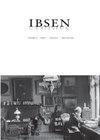The Master Builder’s Tragic Quotidian
IF 0.6
0 THEATER
引用次数: 2
Abstract
Symbolist playwright Maurice Maeterlinck’s l’Intruse (1890, The Intruder) and Henrik Ibsen’s Bygmester Solness were first staged together at Théâtre de l’Œuvre on 13 April, 1894. The day before this performance, Maeterlinck’s “A Propos de Solness le Constructeur” (Concerning The Master Builder), was published in le Figaro. In 1896, it was revised and included in le Trésor des Humbles as “le Tragique Quotidien.” Materlinck used his revision to expand on the observation that “Solness est un drame à peu près sans action” (Solness is a drama almost without action), thereby creating a kind of manifesto for modern, “static” theater (A propos de Solness). The Master Builder’s innovative and static qualities were immediately apparent to actors and directors, who struggled to find effective ways of staging Ibsen. At Théâtre de l’Œuvre, Aurélien Lugné-Poe dealt with Ibsen’s innovation by turning to Maeterlinck’s metaphysical interpretation of the play, emphasizing the tacit presence of “occult forces” and Solness’s “personal magnetism” (Deak 1993, 205). The Master Builder – with its tower, dead babies and mourned dolls, its trolls and strange helpers, and its castle in the air “med grundmur under” (with foundations underneath)” – has often been treated as a (lower case) symbolist drama (Ibsen 1892, 89). Nonetheless, Maeterlinck’s perception of a strong affinity between The Master Builder and his own understanding of the ideal modern theater strikes some critics as odd or wrong – especially if they understand Ibsen as a preeminent realist and realism as the precursor to or opponent of Symbolism. One critic particularly averse to the Symbolist interpretation of Ibsen is Joan Templeton, who claims naturalist director André Antoine as the better and more correct director for staging建筑大师的悲剧日常
1894年4月13日,象征主义剧作家莫里斯·梅特林克的《闯入者》(1890年,《闯入者》)和亨里克·易卜生的《比格梅斯特·索恩斯》首次在th tre de l ' Œuvre上演。演出前一天,梅特林克的《关于建筑大师》(A Propos de Solness le Constructeur)发表在《费加罗报》上。1896年,它被修订,并被纳入《卑微的人生》,称为《每日悲剧》。materlink利用他的修正扩展了“Solness est un dramepeu propts sans action”(Solness是一部几乎没有动作的戏剧)的观察,从而为现代“静态”戏剧创造了一种宣言(a propos de Solness)。建筑师大师的创新和静态的品质立即显而易见的演员和导演,谁努力寻找有效的方式上演易卜生。在《thsam tre de l ' Œuvre》中,奥尔姆·卢格姆·坡通过借鉴梅特林克对戏剧的形而上解释来处理易卜生的创新,强调“神秘力量”的隐性存在和索尔尼斯的“个人魅力”(Deak 1993, 205)。《建造大师》——有它的高塔、死去的婴儿和哀悼的娃娃、巨魔和奇怪的助手,还有它的空中城堡“med grundmur under”(下面有地基)——经常被视为(大写)象征主义戏剧(易卜生1892,89)。尽管如此,梅特林克认为《建筑大师》与他自己对理想现代戏剧的理解之间有着强烈的亲和力,这让一些评论家感到奇怪或错误——尤其是如果他们把易卜生理解为杰出的现实主义,而现实主义是象征主义的先驱或反对者的话。琼·坦普尔顿(Joan Templeton)是一位特别反对易卜生的象征主义解读的评论家,她声称自然主义导演安德烈·安托万(andr Antoine)是更好、更正确的舞台导演
本文章由计算机程序翻译,如有差异,请以英文原文为准。
求助全文
约1分钟内获得全文
求助全文

 求助内容:
求助内容: 应助结果提醒方式:
应助结果提醒方式:


